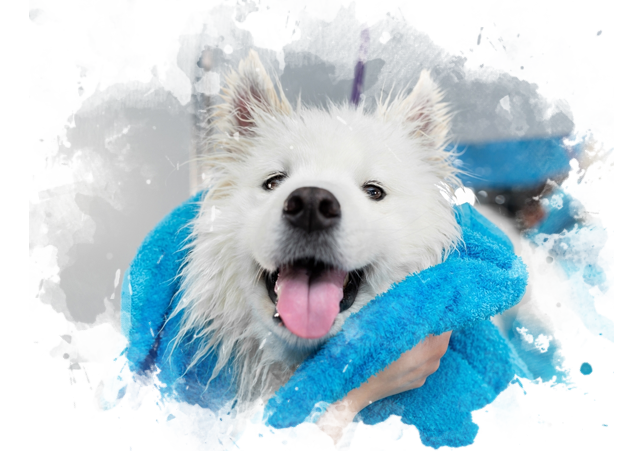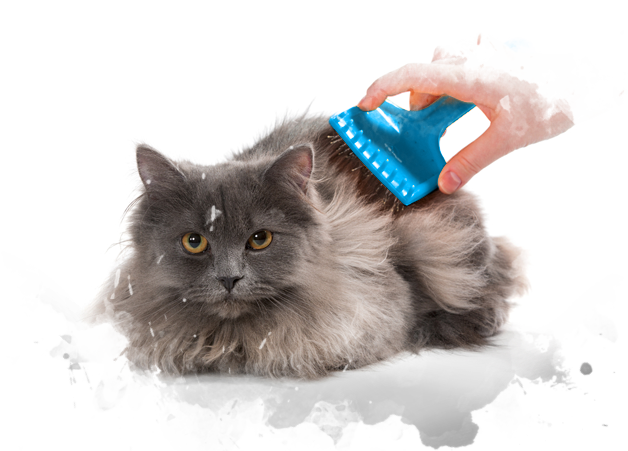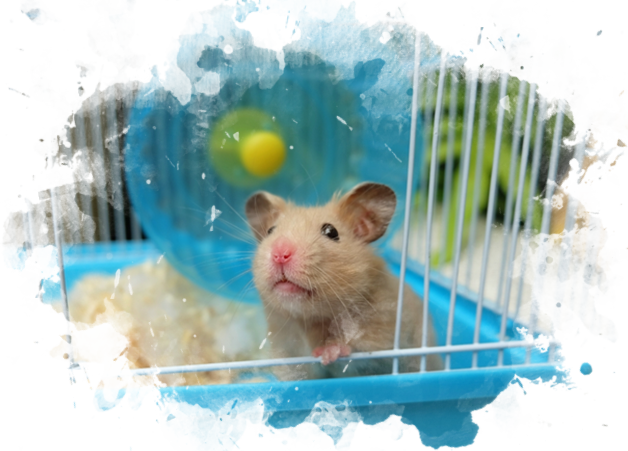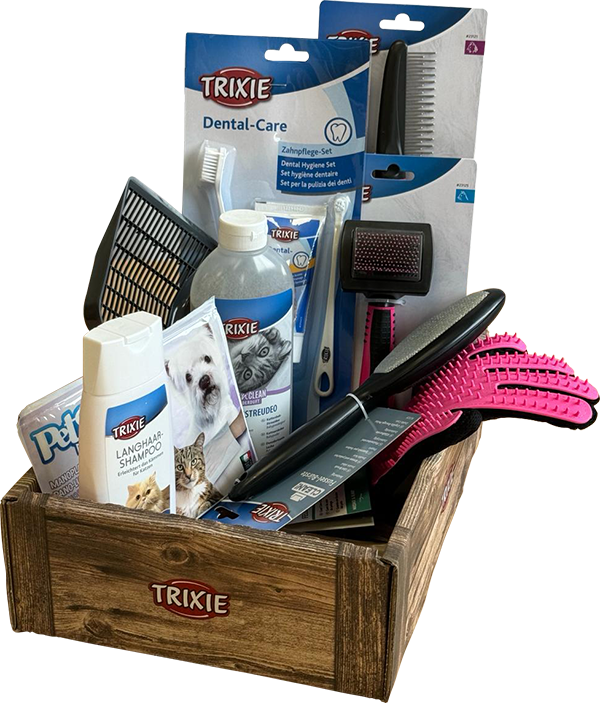In addition to the obvious hygiene routines that we all have in our heads (coat, management of excrement...), the approach to sanitising and caring for our pet goes much further. We start from a healthy habit that we will almost always carry out at home, as washing and grooming is probably the most common way to clean and care for our pets. the most intimate act for any living being.
And in this chapter we will see how we invade this space of our pet, getting him or her to emotionally allow us access to him or her. And going even further: what we are looking for is an extreme case, because our pet must allow us to an animal of another species (us) to take care of it by sanitising it.
Therefore, the approach to hygiene and care will be based on the emotional health. Because after his mother has cared for him at birth, our pet will "let" himself be cared for by a human (another species) in a much more intimate and richer expression of trust than we are used to when dealing with aspects of hygiene and care.
Hygiene and care not only touches on aspects of the coat or organs, but also living spaces, stages, situations or periods of the year. However, the most important aspects are those that relate to the relationship between the person and the pet. Even so, in this chapter we will deal with hygiene as the most useful and preventive measure when our pet is healthy. And likewise, in case you have contracted an illness or have a special situation, we will address care that we should practise at home.
"The trust that comes from being handled when you are dirty or sick with a different animal of another species, is the greatest demonstration of trust".
How do I get my dog used to being hygienic?
The habit of hygiene in dogs should focus on their comfort in the home, encouraging the prevention of disease. This is why the relationship of trust with the dog is so crucial, as you will be invading intimate areas that are very sensitive for him or her in order to clean them. The dog's outings can be a source of dirt and therefore a source of infection. Therefore, prevention before, during and after the walk is the smartest way to maintain hygiene in the home and avoid having to apply care caused by any disease. And, of course, the common areas of the home for the rest. Hygiene control should help to ensure that our environments are suitable for all members of the household to live in.

In health: Fur and skin
Parts of the coat and the different breeds.
We must understand that a dog's coat is first and foremost for protection. Therefore, the person's job is to take care of it so that it continues to protect our friend. The fundamental parts are the layers of the innermost layer: skin, undercoat and outer coat.
- The coat protects against UV radiation, rain, snow and wind. In addition, it repels water and dirt.
- The undercoat has a temperature regulating effect in hot and cold climates and protects against hypothermia when swimming. The undercoat also hinders the penetration of parasites into the skin.

Short hair, long hair; curly, straight or hybrid.
With regard to the different types of coat depending on the breed, they could be classified in a simple way into short and long; as well as curly, straight or hybrid. But in this guide we will look at the more professional and detailed classification provided by Trixie in its catalogue, with examples of the different types of dog and cat breeds to help us differentiate between them:

As we always point out in this Guide, knowing your pet is crucial in order to know how to provide them with the right habits for their overall health. For this reason, for example, it is essential to take into account those breeds that do not have an undercoat, such as curly and smooth coats. This means that the coat of these dogs does not have the same protective functions as that of dogs with the classic two-layer coat. Another important example would be smooth-coated dogs, as they are much more sensitive to cold, but also to heat and sun because they lack the insulating properties of the undercoat. However, breeds with an undercoat need extra care, such as regular brushing of the undercoat during the moulting period, trimming or brushing depending on the coat type.
Brushing
Combing or brushing is not only an aesthetic issue, but above all a preventive one. It is important that at least once a week you comb your dog to remove any parasites that may have reached the pet. After going outdoors in high-risk areas.
The first aspect to take into account, as always, is to know your pet's coat in order to choose the type of bristles the brush should have. In long-haired dogs, the function of the bristles is to remove fur and dead skin cells from deep in the skin. In short-haired dogs, massaging the coat for 5 minutes a day promotes relaxation, stimulates blood circulation, reinforces mutual affection and provides moments of mutual tranquillity. Massage gloves are useful for this, as they achieve the massage and, at the same time, remove dead skin and hair.
Baths: when and how
The most important stage in bathing is puppyhood. From the first vaccination, a puppy should be bathed at home. In this way, from the first months of life, you will gain your dog's confidence in any type of environment, regardless of whether it is not his usual one, such as the bathtub.
It is important that shampoos, especially for puppies, are balanced and easy to dilute, otherwise their skin will be damaged. It is very important that it is in the right concentration so that it can be applied correctly and that the usability at bath time is adequate.
Bathroom recommendations step by step:
- Always brush your dog before bathing.
- Fill the bathtub low.
- Water temperature always warm (also in summer).
- Dilute the shampoo very well.
- Rub the body, legs, tail and belly vigorously. Always leave the head for last.
- Avoid water in the inner ear.
- Rinse thoroughly with flowing water to remove all foam.
- Reward each step with stroking and quick eating rewards.
The highlight: drying
The complete drying of the body after bathing is essential to avoid the proliferation of bacteria, fungus, bad odour and skin infections. It is important to be very energetic in this drying process to ensure that no moisture remains on the body of our animal.
Specific drying towels are very important to avoid bacteria. Dog-specific towels should be used, not human towels. Specific drying towels, antibacterial, fast absorbing, moisture absorbing towels promote a healthy, relaxed and pleasant drying of the dog. After towelling, it is very important to keep the dog warm, and here the option of bathrobes or similar clothing is very useful.
Curly-haired dogs should be dried with a special dog dryer with a powerful blower. The coat is smoothed and the water (and any dust) is literally blown out of the coat. Blow-drying can also be very useful for dogs with a lot of loose undercoat, as this is also blown out of the coat. If this type of dryer is not available, a household hair dryer can also be used as an alternative, but it is very important to make sure that it does not get too hot and is not held too close to the dog. Due to its much less powerful blower, the hair dryer - especially with curly dogs - will achieve a less favourable result.
Even more importantly, dogs that are not yet familiar with blowers or hair dryers should first get used to them, as the noise, temperature and air flow may frighten them.
Protecting the condition of the coat is essential for disease prevention. Emotionally it reinforces bonding, confidence, shelter, self-esteem and affection.
Dry shampoo
Dry shampoo is another useful option. Baths may be recommended every 3-4 weeks, but with dry shampoo you can sanitise your dog more frequently. The most common habits where to use this shampoo would be:
- For dogs with behavioural problems
with water. - After surgery.
- Prevention of parasites: fleas, ticks, lice.
- For Washing puppies in the first three months
until it is vaccinated and can go outside. - Wash, even if not very dirty.
- Washing during the holidays.
- To muzzle a dog that accidentally soils itself.
Different seasons or situations.
Hygiene is directly related to what happens outside. Think, for example, about how seasonal changes affect a dog's coat. For example, in summer there is more dryness because it is harder for dogs to moisturise, so dandruff increases. In these situations, we could counteract these situations with products such as anti-dandruff shampoo. We could give the same examples in times of moulting or when bitches are pregnant.
Therefore, the sex of our pet is also very relevant. There are multiple situations, for example in males, we can address socialisation processes in heat, avoid marking or prevent infections after castration. In the case of females, we will have the menstrual periods, helping the hygienic coexistence with the rest of the family.
In health: Mouth, ears, eyes
Eye care
We should wash our dog's eyes every day, just as we wash our own face every day when we wake up. In this way, we will avoid hardening of the eye lint, sticking to the hair in the area and then we will have to cut them or even injure them.
Dogs with protruding Chihuahua-type eyes often get inflammation if they accumulate more dirt than they should. Cleaning every 15 days with drops and discs or wipes for the external part of the tear ducts. Those with deep-set eyes need the wipes to act on the lower part of the eye area, which avoids discolouration and infections because this is where dirt accumulates. Flat eyes, with sporadic care of the internal and external tear ducts, could be valid, but always checked every 15 days or so. Eye care

Preserving hearing function
This ear canal must be cleaned to avoid internal infections. To do this, lift the ear, tilt our friend's head, apply two drops of the specific products and massage the lower part of the ear/jaw for it to take effect. After this, you must reward the dog because he has allowed you access to a very intimate area.
The outer pinna of the dog's ears should also be cared for. It is an area that accumulates a lot of dirt. They are so large that they pick up a lot of sound and protect against internal infections.
Dogs that do not hear well, do not relate well and feel threatened, so this care is particularly sensitive.

The importance of oral hygiene
Touching a dog's mouth is a very intimate act, probably the most intimate of all. For this reason, the dog should associate it with the most positive sensations possible and treats should play a leading role. Other elements such as toothpaste will be crucial for the dog to directly associate brushing time with something tasty and pleasurable.
By brushing your dog's teeth, you achieve mutual trust, self-esteem reinforcement, teamwork or the promotion of good habits for the whole family. It is very positive that you can establish it as a routine, as when the dog integrates it, it is a process that provides so much relaxation that it is ideal for before bedtime.
Start with the large-headed brushes for the front teeth. Continue with small-headed brushes for molars (molars) and finish with brushes that are inserted into the fingers in the shape of a thimble to reach areas that are sensitive to contact with the inside of the mouth. The rubberised thimble brushes promote gum massage and stimulate blood circulation, which is why they are the most relaxing.
Health: Paws (nails, pads)
When the dog gives you its paw, there is no greater demonstration of trust, since by giving you one of its limbs, it is left in a situation of vulnerability before you. The care of the condition of the paws, drying and cleaning is fundamental for the prevention of illnesses, and emotionally it reinforces the bond, confidence, self-esteem and affection.
The protection of the pads
Pathogens enter a dog's blood mainly through the dog's pads, nose and skin, its three most delicate areas. So before going for a walk we must protect, moisturise and clean them. If the ground is icy or very hot, it is especially important to protect the pads. And when you return, it is important to disinfect them because of what may have adhered to them and because odours from outside remain mainly in the pads, which can be a source of discomfort.
Nail care
Dogs naturally wear down their nails when walking. But you should check them (in winter they don't grow as much) and control them because they can cause damage to themselves by scratching or even to yourself. In addition, nails that are too long can lead to muscular discomfort throughout the body, because if they are long for a long time, they cause bad posture that affects the dog's whole posture. The diagram shows how the posture of the paw and thus the whole body changes if the nails are too long. The dog is forced to shift its weight backwards, which makes it impossible to straighten the paw and changes the whole biomechanics.
Ideally, there should be enough space under each nail of a standing dog, at least 3 to 5 mm depending on the size of the dog. At the latest, when we hear the sound of the nails when walking on a floor, parquet or similar, this is when they should be trimmed. Nail trimming is not easy, so if you are not able to do it, go to the professionals. Hygiene when leaving the house: bags, ...
Hygiene when leaving the house: sachets, ...
Pathogens enter a dog's blood mainly through the dog's pads, nose and skin, its three most delicate areas. So before going for a walk we must protect, moisturise and clean them. If the ground is icy or very hot, it is especially important to protect the pads. And when you return, it is important to disinfect them because of what may have adhered to them and because odours from outside remain mainly in the pads, which can be a source of discomfort.

The importance of smell for them
Let's remember the dog's ability to smell and use it to our advantage. Let's attach a specific scent to the home, a pack scent that makes our pet feel safe and in a state of equilibrium. Certified coat cleaners guarantee the depth of cleaning without compromising the health of the skin. Occasional washing aerates the coat, deep cleans, relaxes the dog and neutralises odours. It is important to know how to disinfect your home and communal areas properly in order to keep them clean and hygienic.
The most delicate spaces are textiles (sofas, carpets...) or those that are less frequented (storage room...). Specialised urine stain removers are not chemical but enzymatic agents. What stops a dog from urinating again is not cleaning/disinfecting it, but rather using specific products to eliminate the olfactory enzymes that make them repeat urination.
Hygiene and the cat: myth or reality?
Basically, there could be two valid options:
Reality. A sense of hygiene is essential for cats to achieve balance within their territory. A cat that senses a territory that is dirty and at risk of being soiled will flee from it, as its instinct will tell it that there is a threat of resources becoming scarce.
This habit brings to light most of the cat habits for which they are most famous: their relationship with water, how we treat their fur, their "quirks" with litter trays... In addition, maintaining a household with many felines must be a major hygiene challenge for the colony to remain stable.

Toilet zones in the territory
The cat's litter tray is its toilet. And from his point of view, you can treat it like all the other elements of the territory: he must be comfortable with it. If not, he may perceive it as a threat and cause him stress. It will therefore be our task to find the right litter tray (or litter box) for our feline. They should be placed in quiet, easily accessible areas, but away from his food space. It is a good idea to provide more than one to give them security in their territory. If you have more than one cat, each cat should have its own and at least two extra ones should be provided.
Individual cat hygiene
Can a cat be bathed? The answer is yes. Identify the breed of cat because some breeds are even water-loving. Although cats do not go out of the house, there may be people who also want to bathe them. The problem we have is that if they have not been used to it, they may be too scared to let us do it. If the cat gets too stressed at that moment and tries to run away continuously, the best thing to do is not to provoke stress and forget about it. If, on the other hand, they do let us try to do it as calmly and cuddly as possible. With a basin of water instead of the shower head. In cats that are not used to it and have to be washed, it should be done with at least two people or use variants such as dry shampoo. At bath time, the bathtub should be set at a water level no higher than knee deep. With lukewarm water, a very gentle rubbing in of the shampoo, as well as a gentle rinse. Never feed before bathing.
Allow the cat to explore its environment immediately after bathing by making sure water and food are available, and a scratching and marking area is prepared.
With regard to other sensitive areas such as the ears, healthy indoor cats, as they do not go out and have their grooming routines, tend to keep their ears clean and do not need frequent cleaning. If the ear is not visibly free of wax or dirt, no intervention is necessary. Outdoor cats may need to have their ears cleaned from time to time. Can a cat be bathed? The answer is yes. Identify your cat's breed because some breeds are even water-loving. Although cats
Different seasons or situations.
Cats have a very sensitive sense of smell. We must be careful when cleaning the house and using disinfectant products or products with very strong smells because they can affect them. We must also be careful with air fresheners. It is important to remove cats from the room we are cleaning, so that they are not attracted to sucking on these products and so that they are not affected by smelling them. When the room has been aired out and everything has dried, let them back in.
How and when to clean our cages?
Controlled territories have the advantage that hygiene management is 100% up to us. So keeping a cage clean is a task for all members of the household, not forgetting small care tasks such as nail control in psittacines or oral hygiene in small mammals.
In order for our bird or rodent to be healthy, we know that environmental enrichment is crucial. However, we need to be aware that this will lead to more cage cleaning, as well as increased maintenance.

Easier cage cleaning with the right bedding
Cleaning the cage is the habit that our pet will obviously be most grateful for. This has benefits for pets and for the home, as having a corner of the house with a cage in poor condition and with bad smells, not only affects the health of our best friend but also affects the coexistence of the home.
The first step in the cleaning process and the one that will help us in all the others is the litter on which our small mammals or birds perch. Decades have passed since the very dangerous newsprint and its highly polluting ink for our pets. But the most environmentally friendly and healthiest solutions for our pets and the environment are still on paper. This time recycled paper pressed into a pellet form that instantly absorbs liquids and odours. These types of solutions are the ones that make progress in the cleaning of cages, as they also make cleaning much easier, quicker and more effective.
Environmental enrichment: more worthwhile clean-ups.
Enriching our pet's environment is undoubtedly the best thing we can do for his health. The downside is that it means that the cage gets dirtier and more frequently. However, betting on the overall health of our friend involves getting involved in this type of habits that are so beneficial for him.
Providing baths for psittacines to moisturise and keep their plumage healthy, checking the nails of small mammals with professional nail clipping or changing the water in turtle tanks are other care that involve maintenance in which the whole family can be involved.
